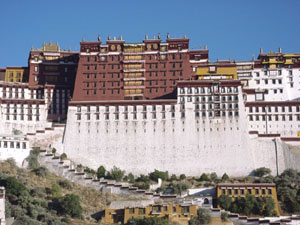
Dzungar (also Jungar or Zungaror Çongar; Mongolian: Зүүнгар Züüngar) is the collective identity of several Oirat (West Mongolian) tribes that formed and maintained the last horse archer empire from the early 17th century to the middle 18th century.
Etymology
After the death of Esen Tayishi in 1454, the political and military unity the Oirat (or West Mongolian) tribes achieved as the Dörben Oirat quickly dissolved. The tribes separated in accordance to traditional tribal divisions, e.g., Olöt, Derbet, Torghut, Khoshot, Khoit, etc. For the next 150 years, the Oirats were not able to form a cohesive political and military entity to combat their enemies and to decide internal disputes.
At the beginning of the 17th century, a young leader named Khara Khula emerged to unite the Oirats to fight Sholui Ubashi Khong Tayiji, the first Altan Khan of the Khalkha. He was a direct descendent of Esen Tayishi and, like Esen, was also the Tayishi of the Olöt tribe. Khara Kula united the Olöt, Derbet and Khoit tribes, thus forming the Dzungar nation. As the leader of three tribes, Khara Khula could only assumed the title Khong Taiji (Supreme Chief). During this era, only the leader of the Khoshot tribe could claim the title of Khan.
Early in his reign in 1606, Khara Khula united the Oirats to fight the Altan Khanate of Sholui Ubashi Khong Tayiji who years earlier expelled the Oirats from their home in the Kobdo region in present-day northwest Mongolia. By 1609, Khara Khula won a decisive victory over the Altan Khanate, forcing Sholui Ubashi Khong Tayiji to withdraw his East Mongol forces from Oirat territory. But the unity dissolved after the victory, as the Oirat Tayishis resumed their traditional ways, favoring complete freedom of action.
The Oirats were under the dominion of Jasaghtu Khan of the Khalkha. Khara Khula seems to have resisted against the Khalkha. In 1623 the Oirat confederation killed Ubashi Khong Tayiji, the first Altan Khan of the Khalkha and gained independence.
In 1636 his son, Erdeni Baatur, joined the Oirat expeditionary force to Tibet, which was led by Güshi Khan of the Khoshot tribe, and assumed the title Khong Tayiji. After he returned to Dzungaria, the Dzungars rapidly gained strength. He made three expeditions against the Kazakhs.
In 1653 his son Sengge succeeded the Dzungars chief, but an internal strife with his half brother Chechen Tayiji involved the Khoshuud. With the support of Ochirtu Khan of the Khoshuud, this strife ended with Sengge's victory in 1661. In 1667 he captured Erinchin Lobsang Tayiji, the third and last Altan Khan. He was killed by Chechen Tayiji in a coup in 1670.
Sengge's younger brother Galdan immediately returned to lay life and took revenge on Chechen. As a Buddhist priest, Galdan had been to Tibet at the age of thirteen and had trained under the fourth Panchen Lama and then the fifth Dalai Lama. In 1671 The Dalai Lama bestowed the title of Khan on him. He came into conflict with Ochirtu Khan. The victory over Ochirtu in 1677 resulted in the establishment of hegemony over the Oirats. In the next year the Dalai Lama gave the highest title of Boshughtu Khan to Galdan.
In 18th century, they were annihilated by Qianlong Emperor in several campaigns. In 1755, the Manchu Empire attacked Ghulja, and captured the Dzunghar khan. Over the next two years, the Manchus and Mongol armies of the Qing dynasty destroyed the remnants of the Dzunghar khanate. Some 600,000 Dzungars were killed following the Manchu conquest in 1755-1757. To commemorate his military victory, Qianlong established the Puning Temple Complex of Chengde in 1755.
No comments:
Post a Comment